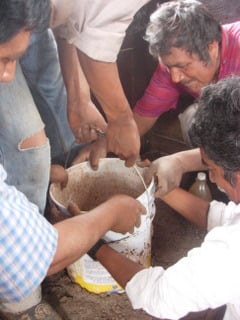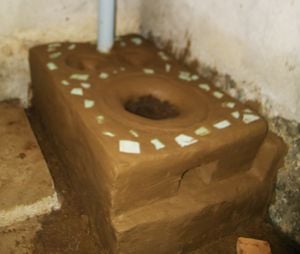
Organization Summary
Location
Francisco I. Madero 49
Barrio de Guadalupe 29230 San Cristóbal de las Casas
Chiapas, México
Contact info
- email: taniagonzalez[AT]otrosmundoschiapas.org
- Tel/Fax: 0052 967 631 6643
- website: http://www.otrosmundoschiapas.org
Mission statement
Otros Mundos (Other Worlds), A.C. of Chiapas tries to look for alternatives to the social, economic, political and environmental crisis that come about through the current system of capitalistic domination.
Otros Mundos, A.C. de Chiapas pretende aportar en la búsqueda de alternativas a la crisis social, económica, política y medioambiental que atravesamos en el actual sistema de dominación capitalista.
Programs
- Economic Justice and Human Rights
- Reclamation of Mining and Hydrocarbons
- Food Sovereignty and Biofuels
- Climate Justice, Forests and Biodiversity
- Gender
- Communication
- Community Mental Health
- Water and Energy
Stove program summary
Name of stove
Custom Lorena Stove
Stove description

Otros Mundos (OM) disseminates a unique version of the Lorena stove. OM staff members worked closely with families in Yibeljoj Village to collaboratively design a stove model. Through a participatory design process community members chose the Lorena stove with modifications. The stove has regular 50 cm diameter comal and two secondary burn chambers for additional pots. The design was modified by essentially eliminating the "boot" portion of the rocket box so that the hot gases go directly to the secondary burn chambers without being redirected upwards. The stove is built primarily from rammed earth with a finish coating of wire mesh, cement, clay and sand. The primary combustion chamber sits directly below the main comal. Two secondary burn chambers are custom built to create a seal around each user's pots.
Criteria:
- Meets the needs of the people as defined by the people.
- Can be built with locally procured materials.
- Can be built by community members.
"What the people tell you is that they like it a lot because they can build it themselves, and if it breaks, they know easily how to do the repair. It doesn’t bring in hardly any materials from outside. Although the chimney is brought in from outside, it will last many years. As for the infrastructure of the stove, they now have the knowledge of how to build it. - Tania Gonzalez, Program Coordinator
Dissemination strategy
The stove building program is one component of the Agua Energia (Water Energy) project that OM is implementing in their target communities. The overall objective of Agua Energia is to promote self sufficiency through appropriate technologies adoption. Other technologies that are being implemented by OM are rainwater catchment systems, composting toilets and biodigesters. Otros Mundos stove dissemination program strategy is unique in many ways. As with all of their technology transfer projects OM considers local knowledge and to be perhaps the most important initial consideration. The first step OM takes is to convene a community meeting to discuss the proposed technology and why it is important. In this meeting issues are discussed including: forest conservation, wood gathering, household economics, the relationship breathing smoke and sickness.
Dissemination strategy development and background
OM technology dissemination program began in 2008. The idea for this program was to have a (“escuela popular de agua energia”) Energy-Water Public School. The objective of this school was to train technology promoters in Agua Energia through a public environmental education program. Promoters are people who are activated by their community to go out and take part in capacity building programs and then return and transfer the knowledge, information and technology back to the community. OM staff facilitated 8 capacity building models with systems such as water treatment, rainwater catchment, solid waste residual anaerobic biodigesters, agro-ecology and agro-forestry. This was a travelling school that went from village to village with each learning module. Throughout the first year OM learned that this model was not going to work because of the time limitations of the "village promoters."
Because for these individuals from the community, this was an extra responsibility. And it is a responsibility that is not paid. So it was like your community gives you a chore or names you to do something and you represent the community and you have to give your time to do the capacity building and then after that take your time to return the information to the communities, give follow ups and all that. Also, normally the people that are community promoters, because they are the type of person that is always active, and always participate in these things, then a lot of responsibility falls on this type of person. - Tania Gonzalez, Program Coordinator
The result of these lessons learned was that OM adjusted their strategy to focus at the level of the family. Building workshops are carried out with family units rather than with community representatives.
Follow up
OM's follow up program is called the "Web of Sustainable Family Systems” (La Red de Sistemas Familiar Sustentables). This is a system of “family indicators” that wwas developed and is implemented by the families themselves. To measure the indicators the family has a facilitated discussion and the family members themselves measure and report their own results with a questionnaire that is provided to them.
Otros Mundos observations
"From the perspective of the communities we serve the metal plancha is really expensive. It’s an amount of money that they just don’t have...For someone to be able to save 40 USD to buy a metal plate is impossible. This is why for these programs to work normally they have to be from the government and are subsidized. Normally these people find their materials locally. They can get gravel, sand, boards for the mold and so on. But as far as all the things that they need to buy with cash they can’t because there is no disposable money in these communities. So the question is, how can we make it so the stove model is so simple, the most economical that it can be, so that the people are excited and don’t feel like they have some kind of external dependence. This is something that we are working with, something very difficult. And we are in constant reflection, not only with the stoves, but with all the systems that we promote." - Tania Gonzalez, Program Coordinator
Main objectives of stove program
- Increase self sufficiency of the family
- Improve indoor air quality
- Maximize adoption and appropriation of the stove
Target population
- Altas de Chiapas.
- Civil Abejas Communities
Financing mechanisms
Through a mix of private donations, Otros Mundos supplies the metal components including the comal, the chimney and the wire mesh for the outer cement coating. Stove recipients are not required to contribute money but are required to provide the stove base before the construction begins. They are also required to be present and actively contribute to the construction process.
Year started
2008
Number of stoves disseminated
5
Adoption rate
100%
Communities served to date
Nuevo Yibeljob, Chiapas